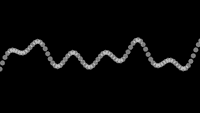Examples+
Graphing 2D Equations
by Daniel Shiffman
Graphics the following equation: sin(ncos(r) + 5theta) where n is a function of horizontal mouse location.
Highlighted Features
/**
* Graphing 2D Equations
* by Daniel Shiffman.
*
* Graphics the following equation:
* sin(n*cos(r) + 5*theta)
* where n is a function of horizontal mouse location.
*/
void setup() {
size(640, 360);
}
void draw() {
loadPixels();
float n = (mouseX * 10.0) / width;
float w = 16.0; // 2D space width
float h = 16.0; // 2D space height
float dx = w / width; // Increment x this amount per pixel
float dy = h / height; // Increment y this amount per pixel
float x = -w/2; // Start x at -1 * width / 2
for (int i = 0; i < width; i++) {
float y = -h/2; // Start y at -1 * height / 2
for (int j = 0; j < height; j++) {
float r = sqrt((x*x) + (y*y)); // Convert cartesian to polar
float theta = atan2(y,x); // Convert cartesian to polar
// Compute 2D polar coordinate function
float val = sin(n*cos(r) + 5 * theta); // Results in a value between -1 and 1
//float val = cos(r); // Another simple function
//float val = sin(theta); // Another simple function
// Map resulting vale to grayscale value
pixels[i+j*width] = color((val + 1.0) * 255.0/2.0); // Scale to between 0 and 255
y += dy; // Increment y
}
x += dx; // Increment x
}
updatePixels();
}
This example is for Processing 4+. If you have a previous version, use the examples included with your software. If you see any errors or have suggestions, please let us know.





